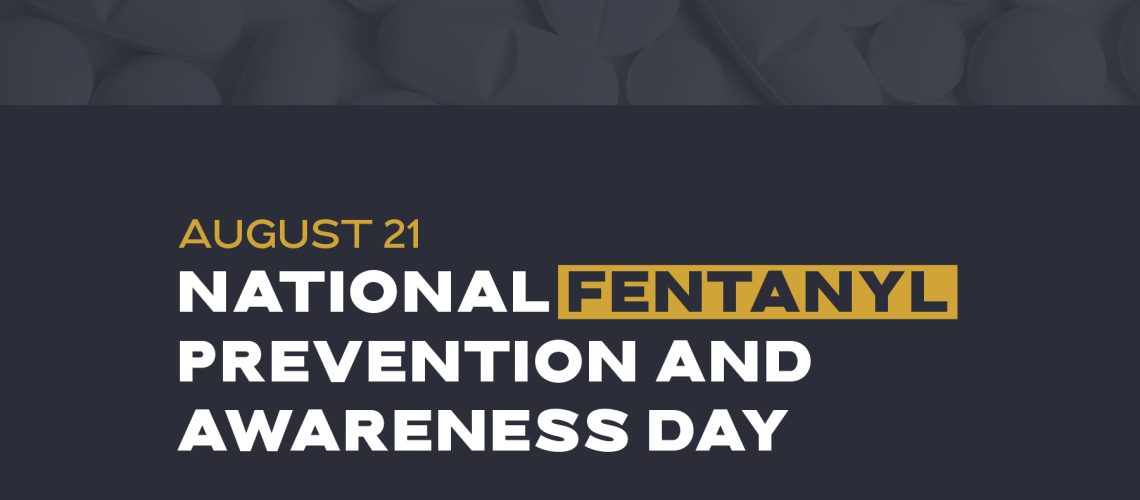
August 21 is National Fentanyl Prevention and Awareness Day
National Fentanyl Prevention and Awareness Day honors those lost to illicit fentanyl. Fentanyl is a synthetic opioid that is up to 50 times stronger than heroin and 100 times stronger than morphine. Over 150 people die every day from overdoses related to synthetic opioids like fentanyl.
Drugs may contain deadly levels of fentanyl and you wouldn’t be able to see it, taste it or smell it. Of note this year, fentanyl mixed with xylazine (a sedative not approved for human use) has been declared an emerging threat in the U.S. due to its impact on the opioid crisis. Xylazine has the potential to be life-threatening, especially when combined with opioids like fentanyl, and has been increasingly detected in the U.S. illegal drug supply.
It is nearly impossible to tell if drugs have been laced with fentanyl unless you test your drugs with fentanyl test strips. Even if you are utilizing fentanyl test strips, it is important to know the signs of an overdose and how to help someone you think might be having one.
WHAT ARE THE COMMON SIGNS OF AN OVERDOSE?
Recognizing the signs of opioid overdose can save a life. Here are some things to look for:
- Small, constricted “pinpoint pupils”
- Falling asleep or losing consciousness
- Slow, weak, or no breathing
- Choking or gurgling sounds
- Limp body
- Cold and/or clammy skin
- Discolored skin (especially in lips and nails)
WHAT SHOULD I DO IF I THINK SOMEONE IS OVERDOSING?
It may be hard to tell whether a person is high or experiencing an overdose. If you aren’t sure, treat it like an overdose—you could save a life.
- Call 911 Immediately.
- Most states have laws that may protect a person who is overdosing or the person who called for help from legal trouble.
- Administer naloxone, if available.*
- Try to keep the person awake and breathing.
- Lay the person on their side to prevent choking.
- Stay with the person until emergency assistance arrives.
*Naloxone (also known by the brand names Narcan® and Kloxxado®) is a life-saving medication that can reverse the effects of opioid overdose and save lives. It is available in all 50 states and can be purchased from a local pharmacy without a prescription in most states. Find out how you can get naloxone here.
COMMON FENTANYL MYTHS
“Naloxone can't reverse fentanyl overdoses"
Truth – Naloxone is an opioid antagonist, meaning that it binds to opioid receptors and can reverse and block the effects of opioids, including synthetic opioids like fentanyl. According to the CDC’s website, naloxone does reverse overdoses caused by fentanyl but an overdose involving fentanyl or other synthetic opioids may require a larger dose of naloxone to reverse.
"You can overdose after touching fentanyl or by touching someone who is overdosing"
Truth – A statement by the American College of Medical Toxicology says that illicit fentanyl is unlikely to cause toxicity via skin exposure. The Centers for Disease Control and Prevention as well as the Office of National Drug Control Policy have put out similar statements.
“It is important that we clarify and let everyone know that fentanyl cannot really be absorbed through the skin because people who have overdosed on fentanyl may have only minutes to live. Pausing or waiting for other people to arrive means that person might die. They need our help and it is safe to help them,” said Daniel Colby, assistant professor and co-medical director for the Department of Emergency Medicine at UC Davis Health.
"Prescription fentanyl is fueling overdose deaths"
Truth – The overwhelming majority of fentanyl overdose deaths involve illicitly manufactured fentanyl and related drugs, which are never prescribed to treat pain and are currently the primary driver of America’s overdose crisis.
If you or someone you know is struggling, SAMHSA’s National Helpline is a free, confidential, 24/7, 365-day-a-year treatment referral and information service (in English and Spanish) for individuals and families facing mental and/or substance use disorders.
To learn more about overdose prevention, visit https://harmreduction.org/.
If someone is overdosing, immediately call 9-1-1 and administer the above steps.
Additional Resources:
https://www.cdc.gov/stopoverdose/fentanyl/index.html
https://www.cdc.gov/stopoverdose/fentanyl/fentanyl-test-strips.html
https://www.cdc.gov/stopoverdose/naloxone/index.html
Share this post
Sign up for our Newsletter
By submitting this form, you are consenting to receive marketing emails from Navis Clinical Laboratories. You can unsubscribe at any time by using the SafeUnsubscribe® link found at the bottom of every email.
